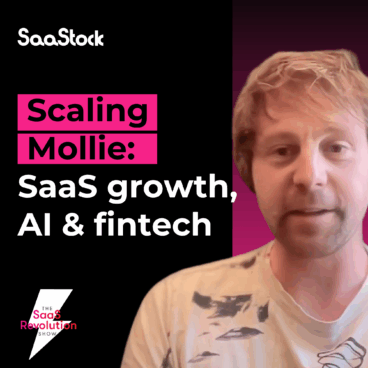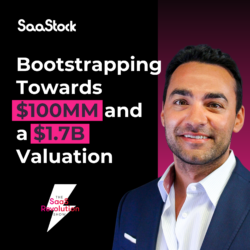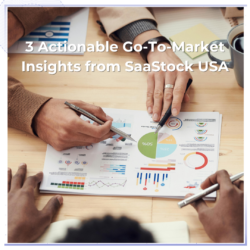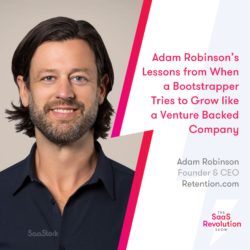In this episode of the SaaS Revolution Show, Alex Theuma talks to Koen Köppen, CEO of Mollie and ex-CTO of Klarna. Since its founding in 2004, Mollie has grown from a Dutch startup to one of Europe’s leading payment processors, serving over 250,000 businesses and achieving €214 million in revenue in 2024—a 28% increase from the previous year.
Koen shares hard-won lessons from Mollie’s ambitious expansion plan, the critical balance between growth and operational efficiency, and how AI is transforming both customer support and product development.
You’ll learn:
- Why operational efficiency must come before growth scaling.
- How to avoid the costly mistake of expanding before product-market fit.
- The “design customer” approach to validating new markets.
- How Mollie is using AI to bridge the gap between customers and engineers.
- Why embedded finance and SaaS are a perfect match.
Watch (or listen) below or read on for key takeaways.
Growth vs. efficiency: Why you can’t have one without the other
Balancing growth and efficiency is a challenge faced by founders around the globe. According to Koen, having operational efficiency under control is the only way for a company to keep growing consistently.
“I’ve experienced hands-on that not prioritising operational efficiency for one period of time ultimately kills your growth.”
Koen advises planning for scale as soon as you have traction in the market. This requires finding balance in your roadmap between new and improved features that drive growth and infrastructure improvements that drive operational efficiency.
Focusing on efficiency early on can also power your expansion efforts further down the line.
Validate product-market fit before you scale go-to-to-market
One of the biggest mistakes Koen sees (and admits Mollie made) is expanding too early. He explained:
“We deployed go-to-market resources before having product-market fit. That was largely driven by hunger for growth. And it’s not helpful.”
This caused misalignment and tension between GTM and product teams in the early days. As Mollie has scaled, and expanded internationally, they’ve taken a different approach, using what they call “design customers” to validate PMF.
“We work with them very closely. We really ensure that they’re happy with our product, that the product is at least as good as what they were using before us. And only once we have proven that 10, 15 times do we start scaling our go-to-market.”
This allows Mollie to expand go-to-market in a much more targeted way—focussing on a certain size of customer or vertical, rather than going too broad and wasting resource. This is something that’s particularly beneficial now that Mollie is ramping up expansion into new markets.
Localisation as a key differentiator
“When you ask our customers how do we stand out? It’s great customer support, being really, really customer centric… And localisation.”
Founded in the Netherlands, Mollie expanded through Europe early. As they grew in new markets, it became clear that localisation was the key to success.
“Europe is a beautiful ecosystem but it’s very dispersed. Different payment methods, different languages, different legislation…it requires you to truly localise your product offering.”
As a company, Mollie has built what Koen referred to as a “factory line” in terms of how they localise markets and deliver product-market fit. This infrastructure in the business is now helping them move towards a lofty goal of serving 31 markets by 2026 (up from 6 in 2024).
This underpins Mollie’s commitment to customer-centricity, something they’re now using AI to scale too.
How AI bridges customers and product development
Rather than chasing hype when it comes to AI, Mollie is embedding AI into processes that directly impact key metrics, and give their customers a better experience.
“AI is definitely delivering significant efficiency gains. But not by putting an agent out there that solves the simple questions and moves the hard questions to a human. The biggest ability that we’ve internally seen of AI is really bridging the gap between customers and engineers.”
At Mollie, every customer interaction, whether phone, email, or chat, is analysed by AI. They aggregate that feedback to understand the problems being surfaced and direct it to the relevant teams.
This process has reduced Mollie’s contact rate (% of customers that get in touch on a monthly basis) by 3x in two years.
“I fundamentally believe that most of your customers don’t wake up with the intention to go and call you. They much rather have a product that actually works.”
Why embedded finance is the future of SaaS
Mollie competes in a competitive fintech market. As the industry shows no sign of slowing, Koen is bullish on embedded finance and its importance for SaaS.
“Good SaaS provides an end-to-end solution to real business problems. Embedded finance unlocks that by automating financial workflows that used to live in a separate system.”
This includes things like payments, invoicing, payroll, and lending being delivered inside the SaaS tools users already live in. Mollie has already expanded its product set from online payments into POS, capital, and B2B invoicing.
“We’re in the early innings of going broader into business banking to meet the real financial needs of our customers.”
For SaaS founders, Koen added:
“Embed financing or fintech early. It unlocks new revenue streams—and automates your customers’ workflows end to end.”
While building and scaling a business across multiple dimensions presents exciting opportunities, it also creates unique challenges for leadership.
Managing context-switching
For Koen, context switching is one of the most challenging parts of being a CEO:
“The biggest personal challenge for me is still very much how broad a job is. Just the amount of context switching is brutal at times.”
Coming from a technical background, Koen found this particularly tough. He said:
“I’m an engineer, I’m used to leading larger engineering teams, setting a technology vision and delivering against that, but you find yourself in a CEO role and it’s so broad, you’re expecting to have an opinion about everything.”
To combat this, Koen tries to be deliberate with his schedule to make time for focus, he added:
“I try to create different themes around different days but it’s not always possible. Sometimes reality kicks in and you have to free up your schedule and you ultimately have to solve the problems that are most urgent, the most pressing.”
Catch up on The SaaS Revolution Show
Hear more from the founders and CEOs shaping the future of SaaS and AI.





